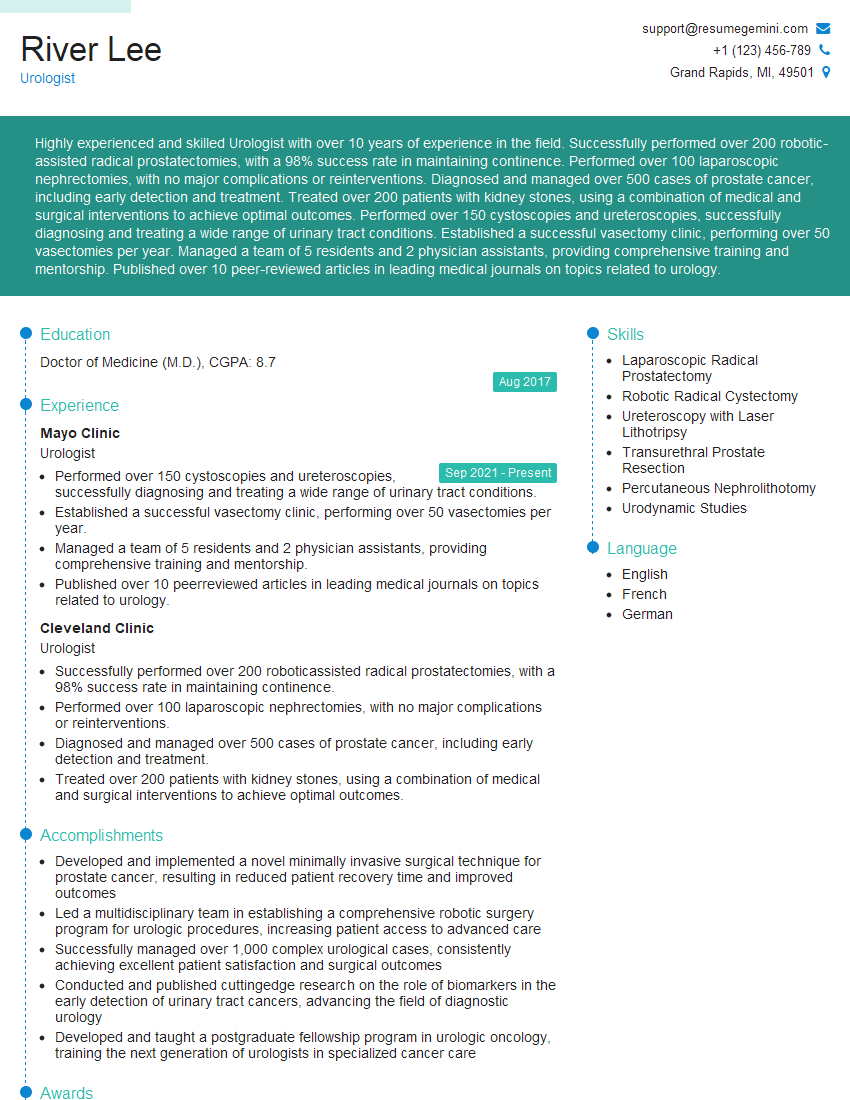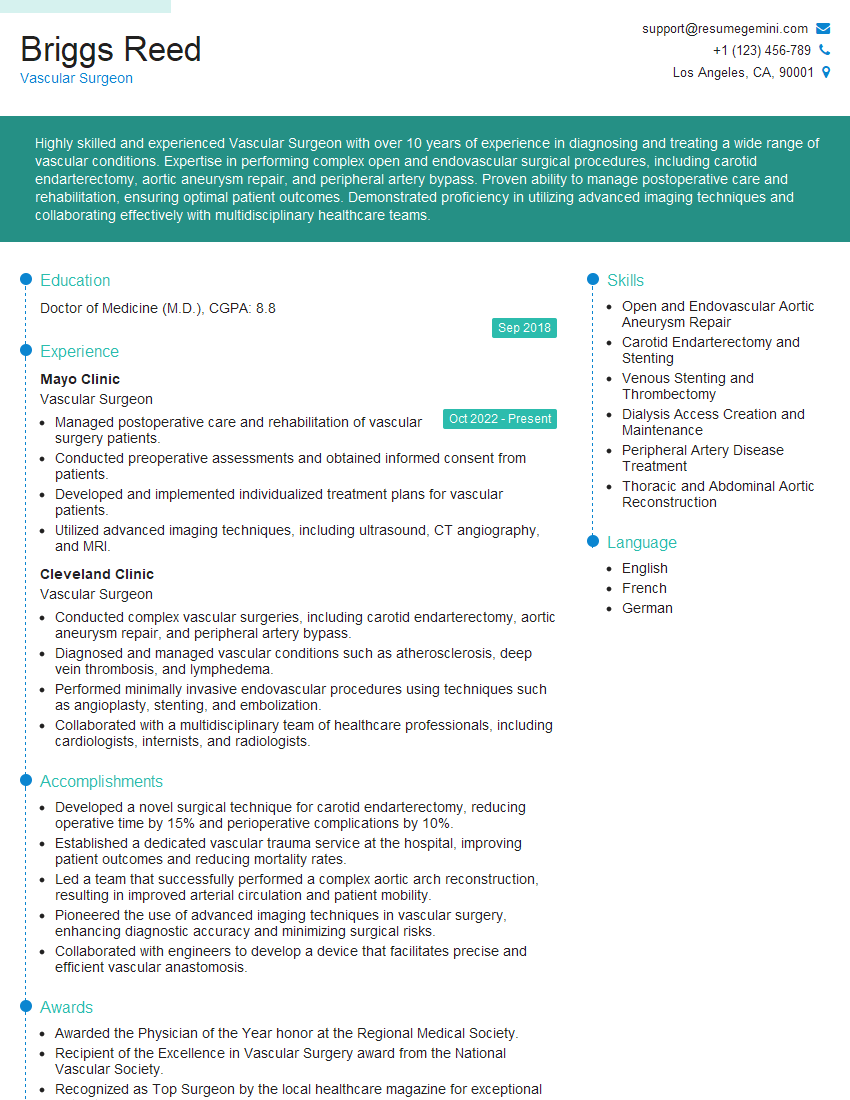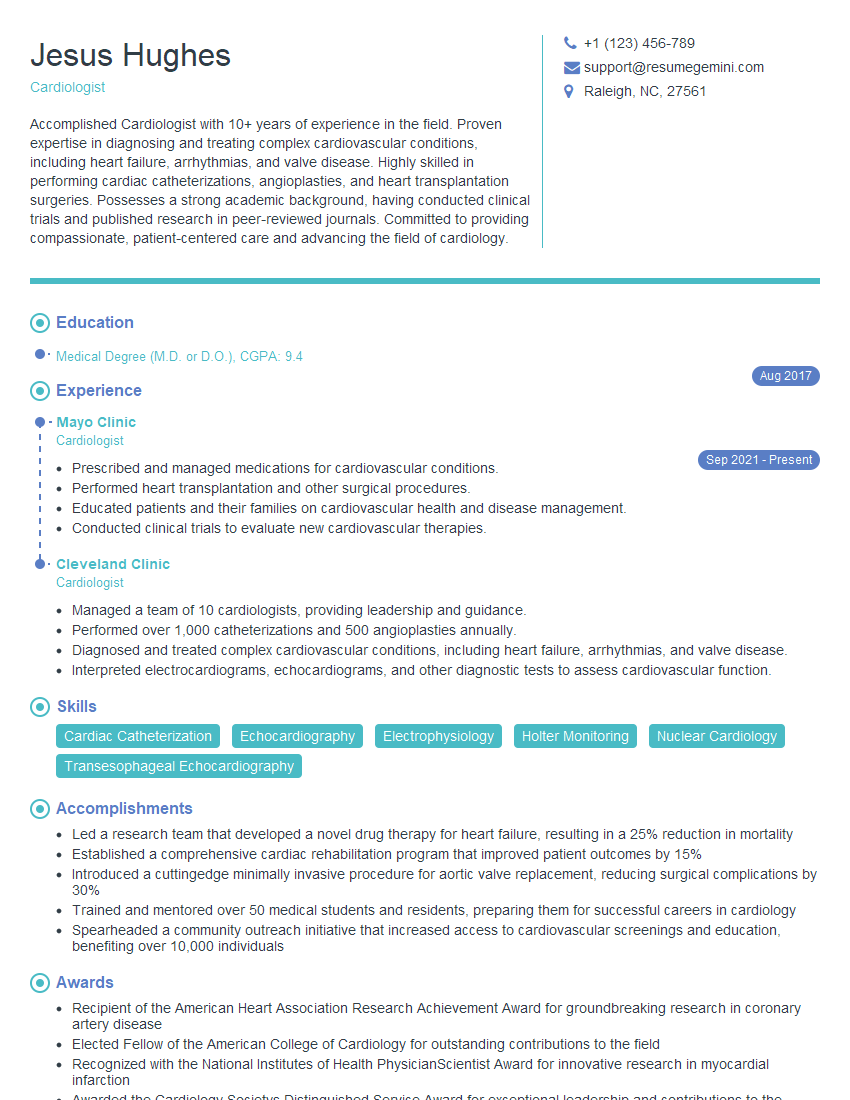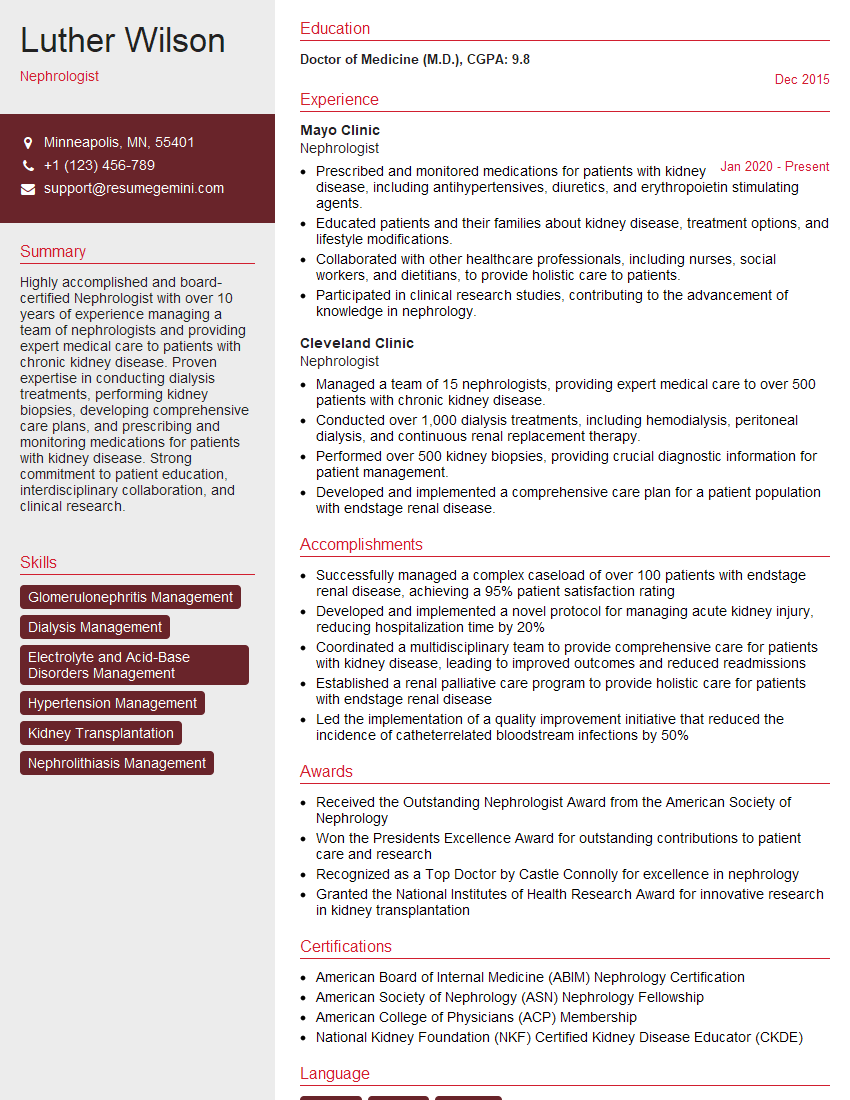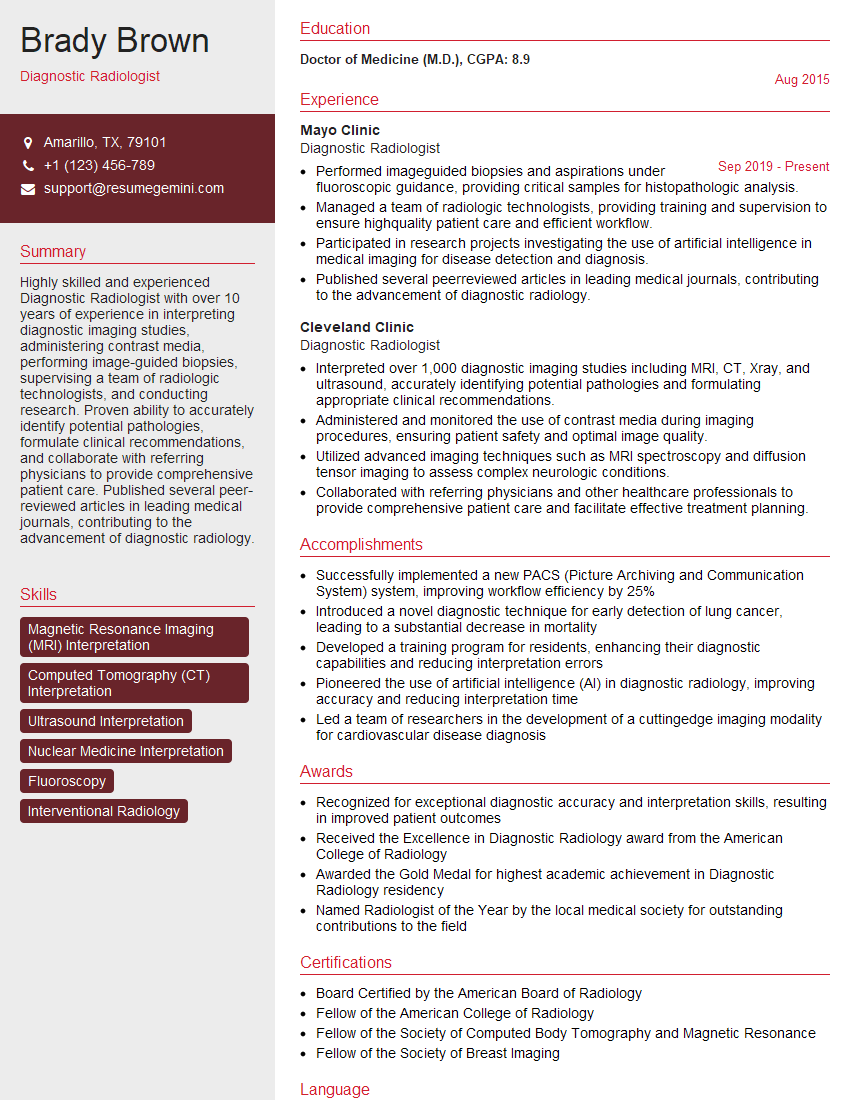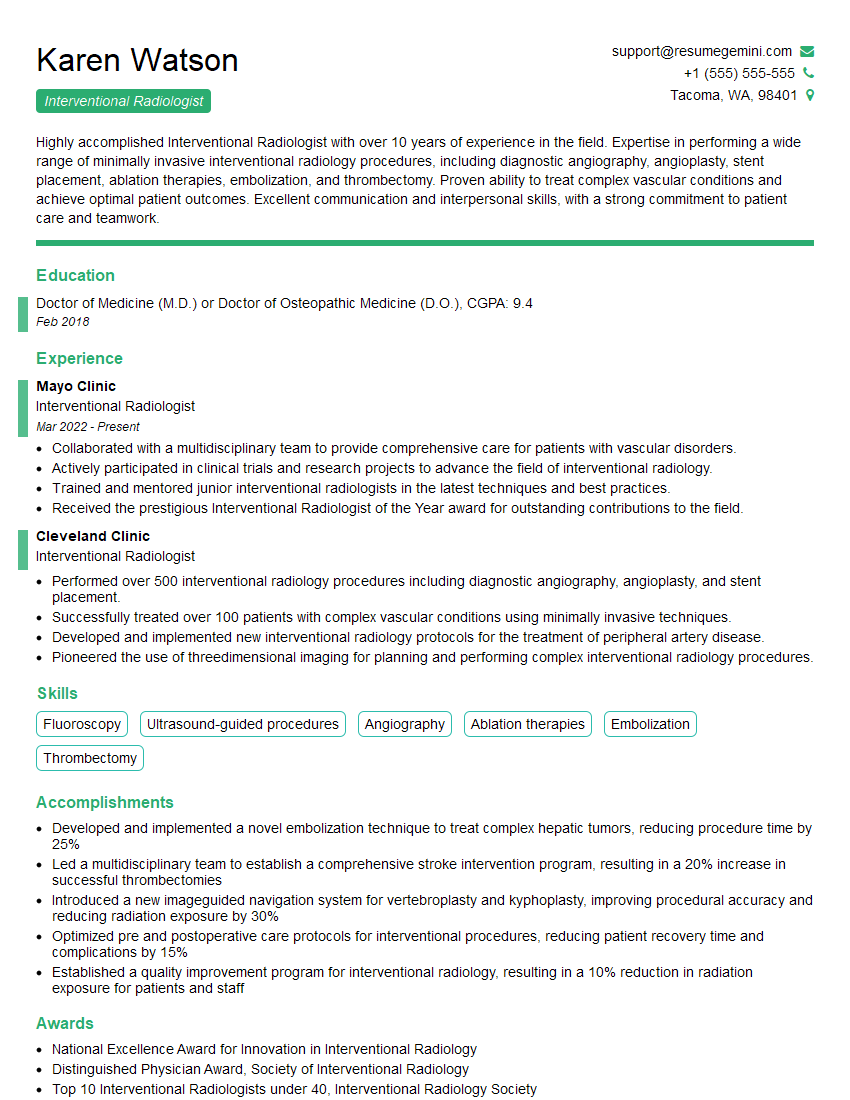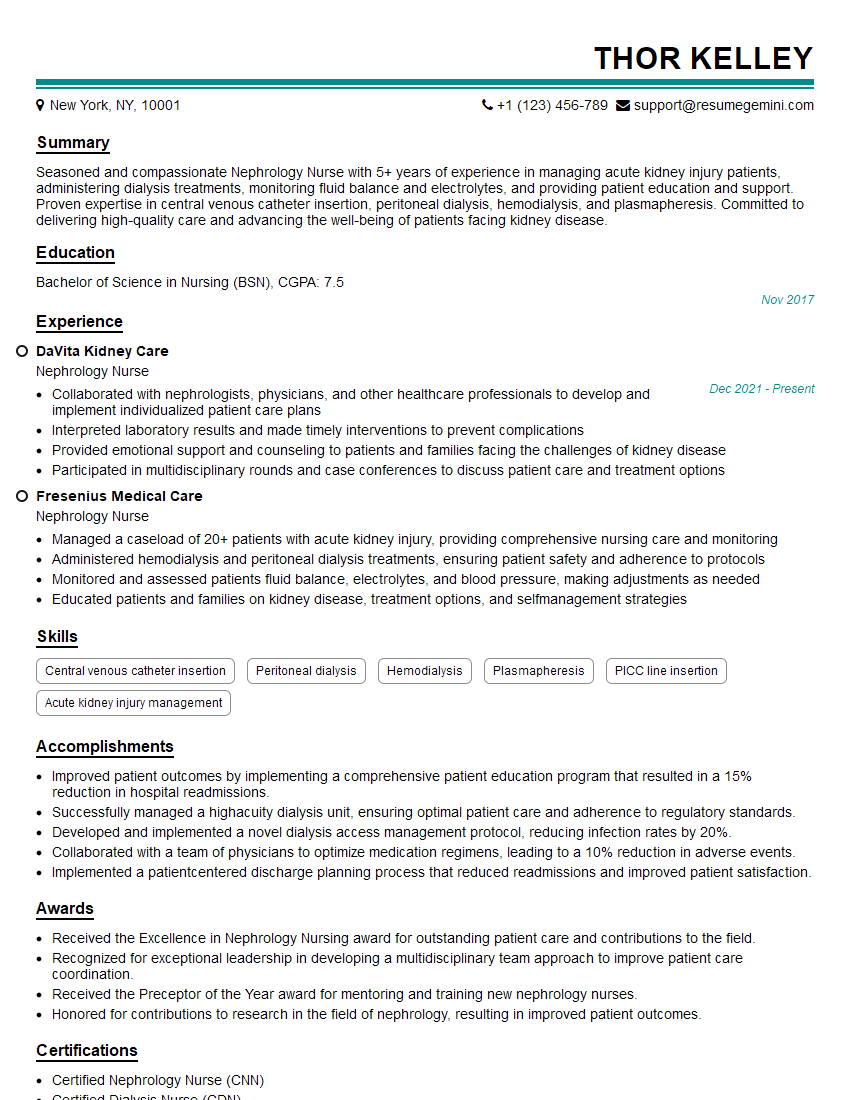Every successful interview starts with knowing what to expect. In this blog, we’ll take you through the top Pigtail Catheter Placement interview questions, breaking them down with expert tips to help you deliver impactful answers. Step into your next interview fully prepared and ready to succeed.
Questions Asked in Pigtail Catheter Placement Interview
Q 1. Describe the Seldinger technique for pigtail catheter placement.
The Seldinger technique is the standard approach for pigtail catheter placement. It’s a minimally invasive procedure that uses a guidewire to facilitate catheter insertion. Imagine threading a needle through fabric – the guidewire acts like the needle, creating a pathway for the catheter. First, a small incision is made, and a needle is advanced into the target vessel (e.g., renal artery or vein). Once the vessel is accessed, a guidewire is passed through the needle, which is then removed. A dilator, a tube used to widen the pathway slightly, is advanced over the guidewire, followed by the pigtail catheter itself. Finally, the catheter’s position is confirmed using fluoroscopy (real-time X-ray imaging) to ensure it’s correctly placed within the intended vessel. The curved (pigtail) design helps prevent the catheter from migrating.
Q 2. What are the indications for pigtail catheter placement?
Pigtail catheters are used for a variety of procedures. Their primary function is to provide drainage or access for diagnostic or therapeutic interventions. Common indications include:
- Renal angiography and intervention: Diagnosing and treating renal artery stenosis or other kidney-related conditions.
- Biliary drainage: Draining bile from the bile ducts in cases of obstruction.
- Drainage of fluid collections: Draining abscesses or cysts.
- Delivery of medications: Directly administering chemotherapeutic agents or other medications to a specific location.
- Sampling: Obtaining samples of fluids or tissues from the target area for diagnostic testing.
Essentially, whenever there’s a need for access to a vessel or body cavity for sampling, drainage, or therapeutic intervention, a pigtail catheter might be the ideal choice.
Q 3. What are the contraindications for pigtail catheter placement?
While relatively safe, there are situations where pigtail catheter placement might be contraindicated:
- Severe coagulopathy: Patients with significant bleeding disorders are at increased risk of hemorrhage.
- Uncontrolled infection at the insertion site: This could lead to sepsis.
- Severe patient instability: Patients who are hemodynamically unstable might not tolerate the procedure.
- Inability to obtain adequate vascular access: If the target vessel cannot be easily accessed, the procedure may need to be modified or abandoned.
- Patient refusal: Informed consent is crucial, and the patient has the right to refuse the procedure.
A thorough assessment of the patient’s overall health is crucial to determine suitability.
Q 4. Explain the different types of pigtail catheters and their applications.
Pigtail catheters come in various designs tailored to different applications. Key differences lie in their material, size, length, and the number of side holes (for drainage).
- Material: Common materials include polyurethane and silicone, each with differing biocompatibility and flexibility properties.
- Size: The diameter (French size) is chosen based on the vessel size and intended application. Larger catheters are used for drainage, while smaller ones may be used for sampling.
- Length: The length depends on the anatomical location of the target site.
- Number and location of side holes: Catheters with multiple side holes facilitate efficient drainage. The placement of these holes is designed to optimize drainage from the targeted area.
For instance, a longer, larger catheter with multiple side holes is suitable for biliary drainage, whereas a smaller catheter might suffice for selective renal angiography.
Q 5. What are the potential complications associated with pigtail catheter placement?
While generally safe, potential complications can arise with pigtail catheter placement:
- Bleeding: Hemorrhage at the insertion site is a risk, though usually minimal.
- Infection: Infection at the insertion site or bloodstream infection (sepsis) is a possibility. Prophylactic antibiotics are often used.
- Thrombosis: Formation of blood clots around the catheter.
- Catheter migration: The catheter may dislodge from its intended position.
- Vessel perforation: Accidental perforation of the vessel during placement.
- Allergic reactions: Rare but possible reaction to catheter material.
Careful technique and close monitoring help minimize these risks.
Q 6. How do you select the appropriate size and length of a pigtail catheter?
Selecting the appropriate size and length is crucial for successful pigtail catheter placement and optimal patient outcomes. The catheter should be sized to fit comfortably within the target vessel without causing damage or occlusion. The length must be sufficient to reach the target location and provide adequate working length.
Consider these factors:
- Vessel size: Use fluoroscopy to assess the vessel diameter and select a catheter with a diameter appropriately smaller to avoid occlusion or damage.
- Target location: Anatomical location dictates the required catheter length. A longer catheter is necessary for deeper structures.
- Clinical indication: The procedure’s purpose also influences the choice; drainage requires a catheter with larger diameter and potential side holes, while diagnostic sampling might necessitate a smaller diameter.
I always meticulously review the patient’s imaging (ultrasound, CT) before making a decision.
Q 7. Describe the steps involved in preparing a patient for pigtail catheter placement.
Patient preparation is paramount. This involves:
- Informed consent: The patient must understand the procedure, risks, and benefits.
- Assessment: Complete physical examination, focusing on cardiovascular and renal function, and coagulation status.
- Antibiotic prophylaxis: Prophylactic antibiotics are often given to reduce the risk of infection.
- Monitoring: Vital signs and ECG monitoring during the procedure.
- Skin preparation: The insertion site is cleaned and sterilized.
- Positioning: The patient is positioned appropriately for optimal access to the target vessel.
Preparing the patient comprehensively ensures a smooth procedure and mitigates potential complications. A calm and well-informed patient will also help alleviate procedural anxiety.
Q 8. What imaging modalities are used to guide pigtail catheter placement?
Pigtail catheter placement is almost always guided by imaging modalities to ensure accurate and safe positioning. The most common methods are fluoroscopy and ultrasound. Fluoroscopy provides real-time X-ray imaging, allowing the physician to visualize the catheter’s progress as it’s advanced. This is particularly useful for navigating complex anatomy. Ultrasound, while not providing the same level of detail as fluoroscopy, offers a non-ionizing alternative, useful in certain situations or for real-time monitoring of fluid drainage. In some cases, CT scans might be used pre-procedurally to plan the approach, particularly in complex cases or when there are pre-existing anatomical variations.
For instance, fluoroscopy is invaluable in navigating the tortuous path through the renal collecting system to reach the desired location within the kidney. The physician can precisely adjust the catheter’s position to avoid injury to surrounding structures. Ultrasound offers a valuable alternative in cases where radiation exposure needs to be minimized, such as in pregnant patients or those needing repeated procedures.
Q 9. How do you confirm proper placement of a pigtail catheter?
Confirming proper pigtail catheter placement is crucial to ensure effective drainage and prevent complications. We primarily use imaging – fluoroscopy and/or an abdominal X-ray – to visualize the catheter’s tip within the targeted collection system (e.g., renal pelvis, pleural space). The images show the catheter’s position relative to surrounding anatomical structures. We look for evidence of proper coiling of the pigtail within the targeted space. Furthermore, we assess the drainage of fluid. Immediately after placement, we should see the expected type of fluid (urine, pus, blood, etc.) draining from the catheter, confirming patency. Another important aspect is patient assessment – checking for reduced pain, decreased distension, and improvement of clinical symptoms consistent with the underlying pathology.
For example, if the catheter is placed for a renal collection, we expect to see a clear drainage of urine. If the drainage is minimal or absent, it may indicate a blockage or malposition. If the drainage is bloody, we investigate further to rule out complications.
Q 10. How do you manage complications such as bleeding or infection after pigtail catheter placement?
Complications like bleeding and infection after pigtail catheter placement are managed promptly and aggressively. Bleeding is often managed conservatively with close monitoring, sometimes requiring blood transfusions depending on severity. If bleeding is significant or uncontrolled, surgical intervention may be necessary. Infections are treated with antibiotics, guided by culture and sensitivity results from drainage samples. In severe cases, catheter removal and surgical drainage may be required. Prompt identification of the source of bleeding or infection is paramount.
For instance, a case of post-procedure bleeding may involve continuous monitoring of vital signs and hematocrit levels. The administration of intravenous fluids and blood products might be necessary. In cases of infection, we obtain cultures from the drainage to guide antibiotic selection, ensuring appropriate treatment of the causative organism. The patient’s clinical status, temperature, and white blood cell count are closely monitored.
Q 11. What are the post-procedure instructions for patients with pigtail catheters?
Post-procedure instructions for patients with pigtail catheters are critical for preventing complications and ensuring optimal outcomes. These instructions typically include educating the patient on signs and symptoms of infection (fever, chills, pain at the insertion site, cloudy drainage), bleeding (significant bleeding, blood clots), and catheter blockage (absence or decreased drainage). Patients are instructed on proper catheter care, including keeping the insertion site clean and dry, preventing kinks or obstructions in the tubing, and avoiding activities that could dislodge the catheter. They are also instructed on the appropriate drainage system collection and emptying procedures. Finally, they are scheduled for follow-up appointments for catheter removal or assessment.
A practical example is advising the patient to immediately report any fever, chills, or significant increase in pain around the insertion site, signs that could indicate infection. Regular monitoring of the drainage, noting the volume and character, will help detect potential blockages.
Q 12. How do you troubleshoot a pigtail catheter that is malpositioned?
Troubleshooting a malpositioned pigtail catheter involves a systematic approach. First, we obtain an imaging study (fluoroscopy or X-ray) to confirm the exact location of the catheter tip. If the catheter is only slightly displaced, we may attempt repositioning under fluoroscopic guidance. This often involves gently manipulating the catheter with careful maneuvers. However, if repositioning is unsuccessful or if the catheter is significantly malpositioned or causing complications, we may opt for removal and placement of a new catheter. In this scenario, the physician will reassess the optimal approach, taking into account the previous placement attempt.
For example, if fluoroscopy reveals the catheter tip positioned against a blood vessel, we’ll carefully withdraw the catheter and attempt a different approach. If repeated attempts fail or it becomes clear the catheter is causing injury or discomfort, we will remove it and replan the procedure.
Q 13. What are the differences between a pigtail catheter and other types of nephrostomy catheters?
While both pigtail and other nephrostomy catheters are used to drain fluid from the kidney, they differ in design and functionality. The pigtail catheter is characterized by its coiled or pigtail-shaped distal end, which helps to anchor it within the collecting system and reduces the risk of migration. Other nephrostomy catheters, such as straight catheters or double-J stents, lack this coiled design. Double-J stents, for instance, have a J-shaped configuration at both ends, facilitating their placement and minimizing migration. They are often left in place for longer durations than pigtail catheters. The choice of catheter depends on the clinical situation, duration of drainage required, and anatomical considerations. The pigtail catheter is ideal for short-term drainage while the double J is more suitable for longer-term drainage.
To illustrate, a pigtail catheter is typically used for temporary drainage of a renal abscess, while a double-J stent might be placed for long-term management of ureteral obstruction.
Q 14. Describe your experience with different types of drainage systems used with pigtail catheters.
My experience encompasses various drainage systems used with pigtail catheters, each with its own advantages and disadvantages. Closed drainage systems are the most commonly used, minimizing the risk of infection. These systems involve a sterile collection bag connected to the catheter via sterile tubing. Open drainage systems, while less common due to the higher risk of infection, are sometimes used in specific circumstances. There is also a diversity in bag sizes and functionalities available. Some bags have graduated markings for accurate volume measurement, while others include air vents to prevent vacuum formation. The selection of the drainage system is often influenced by patient-specific factors, such as mobility and potential for increased risk of infection.
For example, in a patient who is highly mobile, a smaller, portable drainage bag might be preferred over a large, bedside bag. In patients with immunocompromise, the choice would prioritize minimizing infection risk, potentially opting for a system with additional features to reduce contamination.
Q 15. How do you address patient concerns and anxieties about the procedure?
Addressing patient concerns about pigtail catheter placement begins with open communication and empathy. I start by explaining the procedure in simple, non-medical terms, using analogies to help them understand. For example, I might explain that it’s like inserting a small, flexible straw into a blood vessel to drain fluid or take samples. I answer all their questions patiently, addressing their anxieties directly. If they have fears about pain, I explain the pain management strategies we’ll use. I also reassure them about the safety measures we take, highlighting my experience and the safety protocols followed in our facility. Building trust and rapport is crucial, and I always make myself available to answer questions before, during, and after the procedure. A calm and confident demeanor goes a long way in easing a patient’s anxiety.
Career Expert Tips:
- Ace those interviews! Prepare effectively by reviewing the Top 50 Most Common Interview Questions on ResumeGemini.
- Navigate your job search with confidence! Explore a wide range of Career Tips on ResumeGemini. Learn about common challenges and recommendations to overcome them.
- Craft the perfect resume! Master the Art of Resume Writing with ResumeGemini’s guide. Showcase your unique qualifications and achievements effectively.
- Don’t miss out on holiday savings! Build your dream resume with ResumeGemini’s ATS optimized templates.
Q 16. Describe your experience with fluoroscopy during pigtail catheter placement.
Fluoroscopy is indispensable during pigtail catheter placement. It provides real-time imaging, allowing me to visualize the catheter’s path as it’s advanced through the vasculature. This is crucial for precise placement and to avoid complications like perforation or arterial puncture. My experience with fluoroscopy includes using it to guide the catheter to the target location, confirming its position, and assessing the surrounding anatomy. I’m proficient in adjusting the fluoroscopy settings to minimize radiation exposure to both the patient and myself, always employing the ALARA principle (As Low As Reasonably Achievable). I meticulously document the fluoroscopic images and measurements, which are essential for accurate procedural records and post-procedure evaluation. For instance, in one case, fluoroscopy allowed me to identify an unexpected vascular anomaly, preventing a potentially serious complication.
Q 17. Explain the role of sterile technique in pigtail catheter placement.
Sterile technique is paramount in pigtail catheter placement to prevent infection. This involves meticulously preparing the insertion site with antiseptic solutions, using sterile drapes and gloves, and maintaining a sterile field throughout the procedure. Any equipment that comes into contact with the patient’s body must be sterile. We follow strict protocols for handling catheters, ensuring they remain sterile until insertion. Failure to maintain sterile technique can lead to serious complications like bloodstream infections, which can be life-threatening. Strict adherence to these protocols is a non-negotiable part of my practice, and I regularly review and update my knowledge of infection control guidelines to maintain the highest standards of patient safety.
Q 18. What are the safety measures you take during pigtail catheter placement?
Safety is my utmost priority. Before the procedure, I thoroughly review the patient’s medical history, including allergies and coagulation status. I use appropriate size and type of catheter based on the patient’s anatomy and the procedure’s goals. During the procedure, continuous monitoring of vital signs is essential. I also carefully assess the patient’s response to the procedure, monitoring for any signs of complications like bleeding, pain, or changes in heart rate or blood pressure. In addition to using fluoroscopy for guidance, I employ techniques like manual pressure and haemostasis to minimize bleeding. Post-procedure, I carefully monitor the insertion site for signs of infection or bleeding. Continuous education and adherence to established safety protocols are vital for minimizing risks and providing the safest possible care.
Q 19. How do you manage patient pain during and after the procedure?
Managing patient pain is a critical aspect of the procedure. Before the procedure, I discuss pain management options with the patient, which might include local anesthesia, sedation, or analgesics. During the procedure, I use techniques to minimize discomfort, like slow and gentle catheter insertion. Post-procedure pain is typically managed with analgesics, the type and dosage depending on the patient’s individual needs and pain level. Regular assessment of pain levels is crucial, and I adjust pain management strategies as needed, ensuring the patient’s comfort and recovery are prioritized. I often emphasize non-pharmacological pain relief strategies, such as relaxation techniques, as well.
Q 20. Describe your experience with managing patients with bleeding disorders during pigtail catheter placement.
Managing patients with bleeding disorders requires meticulous planning and careful execution. Before the procedure, I review the patient’s complete coagulation profile and discuss the risks and benefits with them and their hematologist. I may need to consult with hematology for guidance on appropriate pre-procedural medication, such as prophylaxis with clotting factors. During the procedure, I use smaller gauge catheters and employ gentle techniques to minimize trauma to the vessels. Post-procedure, close monitoring for bleeding is crucial, including meticulous observation of the insertion site and close monitoring of hematologic parameters. I may administer additional clotting factors or other supportive measures as needed. The successful management of a patient with a bleeding disorder hinges on pre-procedural planning, close collaboration with other specialists, and meticulous attention to detail during and after the procedure.
Q 21. What are the different materials used in manufacturing pigtail catheters?
Pigtail catheters are typically made from various materials, chosen based on their biocompatibility, flexibility, and radiopacity. Common materials include polyurethane, silicone, and PTFE (polytetrafluoroethylene). Polyurethane is a widely used material because of its flexibility and biocompatibility. Silicone catheters offer excellent biocompatibility, but they are less flexible. PTFE catheters are highly durable and resistant to kinking but might be stiffer than polyurethane options. The choice of material depends on the specific clinical application and the patient’s individual needs. The catheter may also include a radiopaque material, such as a metal braid or filament, to aid in visualization during fluoroscopy. This ensures the catheter is clearly visible on the X-ray, allowing for accurate placement and monitoring.
Q 22. How do you ensure proper catheter fixation after placement?
Secure catheter fixation is paramount to prevent dislodgement, infection, and patient discomfort. After successful pigtail catheter placement, I employ a multi-pronged approach. First, I ensure the catheter is appropriately positioned, confirmed by fluoroscopy and/or contrast injection. Then, I secure the catheter to the skin using a sterile dressing and appropriate fixation devices, such as sutures or specialized adhesive tapes designed for catheter fixation. The choice of method depends on the patient’s individual characteristics and the anticipated duration of catheterization. For instance, a patient prone to movement might necessitate sutures for more robust fixation. The dressing should be meticulously applied, covering the insertion site and securing the catheter tubing to minimize friction and movement. Finally, the catheter hub is clearly labeled with the date and time of placement, the catheter type and size, and the intended use. Regular assessment of the insertion site and fixation is crucial, checking for signs of infection or dislodgement, adjusting or replacing the dressing as needed.
Q 23. How do you choose the appropriate puncture site for pigtail catheter placement?
Selecting the optimal puncture site for pigtail catheter placement is critical for successful procedure and minimizing complications. The choice is guided by several factors, primarily the target anatomy and the intended use of the catheter. For example, for nephrostomy, I’d typically aim for a flank approach, targeting the posterior calyx. This involves careful palpation and anatomical landmarks to identify the optimal position, minimizing the risk of injuring adjacent organs. Ultrasound guidance is often utilized, providing real-time imaging and precise needle placement. Moreover, we need to consider patient-specific factors, like prior surgeries or anatomical variations. In patients with previous abdominal surgeries resulting in scar tissue, alternative access points might be required to avoid complications. Patient body habitus and overall condition also impact site selection; optimizing comfort and accessibility is a priority. Pre-procedure imaging such as CT or ultrasound is often used to confirm anatomy and plan the ideal puncture site.
Q 24. What are the long-term complications associated with pigtail catheter placement?
Long-term complications associated with pigtail catheter placement are thankfully uncommon but potentially serious. These can include infection (catheter-related bloodstream infection or local infection at the insertion site), bleeding (hematoma formation), thrombosis (formation of blood clots within the catheter or adjacent vessels), and catheter-related obstruction. Chronic pain or discomfort at the insertion site can also occur. The risk of these complications is minimized through strict adherence to aseptic techniques during placement, regular monitoring of the insertion site for signs of infection, and meticulous catheter care including regular flushing and dressing changes. Patient education regarding signs and symptoms of complications is essential for prompt intervention and improved outcomes. For example, regular assessment of vital signs (including temperature), and prompt attention to any reports of pain, swelling, or drainage at the insertion site are critical steps in preventing serious complications.
Q 25. Describe your experience with managing patients with anatomical variations during pigtail catheter placement.
Managing patients with anatomical variations during pigtail catheter placement demands flexibility and experience. I’ve encountered several situations where anatomical abnormalities, such as renal ectopia, horseshoe kidney, or significant obesity, presented challenges. In these cases, pre-procedural imaging (CT, ultrasound) is invaluable. It allows for detailed anatomical assessment, identification of potential obstacles and planning the safest and most effective approach. If a standard approach isn’t feasible due to anatomical variations, I will explore alternative access routes, considering the potential risks and benefits of each approach. For example, in a patient with severe scoliosis affecting renal positioning, I might adapt the angle and trajectory of the catheter insertion to accommodate the spinal curvature. I also always involve the radiology team in complex cases, utilizing their expertise in fluoroscopic guidance and image interpretation to minimize the risk of complications. Clear communication with the patient throughout the procedure is vital. We want the patient to understand the reason for any modifications or adjustments that are necessary.
Q 26. How do you document the pigtail catheter placement procedure?
Accurate and comprehensive documentation of the pigtail catheter placement procedure is paramount for patient safety and legal compliance. My documentation includes a detailed pre-procedure assessment (including the indication for placement, patient’s medical history, relevant allergies and any anatomical variations), a meticulous description of the procedure itself (the access site chosen, the techniques used, any challenges encountered, and the use of imaging guidance), the final position of the catheter as confirmed by fluoroscopy and or contrast studies, and post-procedure observations. I also meticulously record the type and size of catheter used, the date and time of placement, and details about the fixation method. Importantly, I document any medications administered during the procedure and any post-procedure complications or follow-up actions. All of this is entered directly into the electronic medical record to ensure that the information is readily available to the entire care team.
Q 27. What is your approach to managing a clogged pigtail catheter?
A clogged pigtail catheter can significantly impair its function and necessitate prompt intervention. My approach begins with a thorough assessment to determine the cause of the obstruction. This might involve checking for kinks, blood clots, or other debris within the catheter. I will attempt to unclog the catheter using gentle aspiration and flushing with a suitable solution, starting with normal saline and progressing to more potent solutions if necessary, following established guidelines and protocols. If simple flushing fails, I may use a thrombolytic agent, under strict aseptic conditions and in accordance with relevant protocols, for blood clot removal. If the catheter remains obstructed despite these attempts, I would assess whether it is repairable and if the potential benefits of salvaging the existing catheter outweigh the risks of leaving it in place versus attempting to replace it. If the benefits of replacement outweigh the risk and the catheter cannot be salvaged, I would proceed with removal and placement of a new catheter.
Q 28. How do you handle an unexpected complication during pigtail catheter placement?
Handling unexpected complications during pigtail catheter placement requires a calm, systematic approach. My immediate priority is to ensure patient safety. This may involve stopping the procedure to stabilize the patient, managing any immediate complications (such as bleeding or pneumothorax), and carefully assessing the situation. Depending on the nature of the complication, this might involve calling for additional assistance, notifying the anesthesiologist or surgeon, or quickly transitioning to an alternative procedure. For example, if the initial puncture site proves difficult or unsafe, an alternative access point might be selected or imaging guided access used to facilitate catheter placement. If the catheter cannot be placed safely due to unexpected anatomical variance then the procedure needs to be abandoned and an alternative approach considered. Following any unexpected complication, I provide a detailed description of the event, the steps taken to manage it, and the outcome in the patient’s medical record. This documentation is crucial for improving future procedures and facilitating quality improvement initiatives.
Key Topics to Learn for Pigtail Catheter Placement Interview
- Anatomy and Physiology: Thorough understanding of the relevant anatomy (kidney, ureter, bladder) and physiological principles related to urinary drainage.
- Catheter Selection and Sizing: Criteria for choosing the appropriate catheter size and type based on patient factors and procedural needs. This includes understanding the differences between various catheter materials and designs.
- Sterile Technique and Infection Control: Mastering aseptic techniques to minimize the risk of infection during and after catheter placement. This includes hand hygiene, draping, and equipment sterilization.
- Procedure Steps and Techniques: Detailed knowledge of the step-by-step procedure, including patient preparation, puncture site selection, guidewire manipulation, catheter insertion, and securement.
- Fluoroscopic Guidance and Interpretation: Understanding the role of fluoroscopy in guiding catheter placement and interpreting fluoroscopic images to ensure accurate catheter positioning.
- Complications and Management: Identifying potential complications (e.g., bleeding, perforation, infection) and developing strategies for their prevention and management.
- Post-Procedure Care: Understanding post-procedure monitoring, patient education, and follow-up care to ensure optimal patient outcomes.
- Troubleshooting and Problem-Solving: Developing skills to address challenges encountered during the procedure, such as difficulties with catheter advancement or unexpected anatomical variations.
- Legal and Ethical Considerations: Understanding the legal and ethical implications of the procedure, including informed consent and documentation.
Next Steps
Mastering Pigtail Catheter Placement demonstrates valuable technical skills and critical thinking, significantly enhancing your career prospects in interventional radiology, urology, or related fields. To maximize your chances of landing your dream role, creating a strong, ATS-friendly resume is crucial. ResumeGemini is a trusted resource that can help you build a professional and impactful resume tailored to showcase your expertise in Pigtail Catheter Placement. ResumeGemini provides examples of resumes specifically designed for this procedure, giving you a head start in crafting your application materials. Invest in your future – build a resume that highlights your abilities and gets you noticed!
Explore more articles
Users Rating of Our Blogs
Share Your Experience
We value your feedback! Please rate our content and share your thoughts (optional).
What Readers Say About Our Blog
Hello,
We found issues with your domain’s email setup that may be sending your messages to spam or blocking them completely. InboxShield Mini shows you how to fix it in minutes — no tech skills required.
Scan your domain now for details: https://inboxshield-mini.com/
— Adam @ InboxShield Mini
Reply STOP to unsubscribe
Hi, are you owner of interviewgemini.com? What if I told you I could help you find extra time in your schedule, reconnect with leads you didn’t even realize you missed, and bring in more “I want to work with you” conversations, without increasing your ad spend or hiring a full-time employee?
All with a flexible, budget-friendly service that could easily pay for itself. Sounds good?
Would it be nice to jump on a quick 10-minute call so I can show you exactly how we make this work?
Best,
Hapei
Marketing Director
Hey, I know you’re the owner of interviewgemini.com. I’ll be quick.
Fundraising for your business is tough and time-consuming. We make it easier by guaranteeing two private investor meetings each month, for six months. No demos, no pitch events – just direct introductions to active investors matched to your startup.
If youR17;re raising, this could help you build real momentum. Want me to send more info?
Hi, I represent an SEO company that specialises in getting you AI citations and higher rankings on Google. I’d like to offer you a 100% free SEO audit for your website. Would you be interested?
Hi, I represent an SEO company that specialises in getting you AI citations and higher rankings on Google. I’d like to offer you a 100% free SEO audit for your website. Would you be interested?
good
